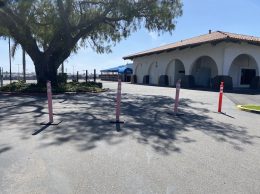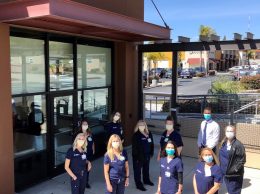Gardening made Ted Hughes feel alive.
The gentle caress of the soil, a flower’s sweet smell — they grounded Hughes, who was dying of colon cancer, reminding him to live in the moment.
“It gives you a chance to see that there’s more to life than what you’re living in,” Hughes said before passing away June 5. “You give a little water and love and, in exchange, that love will be returned.”
Hughes tended zucchini, bell pepper, squash and beets outside Sarah House, a Santa Barbara-based hospice that has cared for the terminally ill poor since 1994.
Volunteer massage therapist Denise Zayas helped dull Hughes’ pain. She kneaded the soles of the 59-year-old’s feet as he reclined in a massage chair.
“I’m trying to create a situation in my life where I can bypass what has possibly been given to me as an outcome — death,” said Hughes, choking back tears. “The people here bring me hope.”
While Sarah House follows a traditional nonprofit model for end-of-life care, many for-profit hospices have been sprouting up nationwide — including several in the Tri-Counties.
Money to be made
Some hospices are profiting by targeting patients with diseases like Alzheimer’s, who live longer, according to a recent study in the New England Journal of Medicine.
As for-profit hospices’ profit margins grow, so has their popularity with investors. The number of nonprofits is dwindling in what is now a booming $18 billion industry in the U.S. and hospice operators expect that trend to continue.
But some for-profit hospices view treatment as just a numbers game and that defeats the purpose of hospice care, said Babetta Daddino, director of Serenity House, an 18-bed nonprofit hospice in Santa Barbara.
“Many for-profits stopped doing (expensive) interventions because it came out of the hospice’s dollar,” said Daddino, who once worked at a for-profit hospice in Alaska. “We’ll do blood transfusions and other procedures if it improves the quality of life. But many for-profits will discharge a patient before doing that.”
Hospices focus on comforting the dying, not curing them. It’s about quality, not quantity of life.
Medicare began paying hospices in 1983 for patients who have given up aggressive treatment and whom doctors only give six months, or less, to live.
But it took a while for the regulatory agencies to catch up, Daddino said.
The hospice industry “went too long, 20-plus years, without any true regulatory oversight,” she said.
Spending soars
While the original idea behind hospice care was to reduce expensive end-of-life, hospital intensive treatment, hospice-related Medicare costs have been steadily increasing.
Medicare spending for hospice care rose by more than 400 percent from $2.9 billion in 2000 to $15.1 billion in 2012, according to the Medicare Payment Advisory Commission (MedPAC), a Medicare watchdog group that Congress created.
What began as a spiritually motivated movement has transformed into an industry dominated by for-profit firms. In 1990, only 5 percent of hospices were for-profit. By 2013, they made up 66 percent of all hospice providers, according to the National Hospice and Palliative Care Organization.
Oakhurst Hospice in Westlake Village is one of those.
Administrator Justin Blake said the for-profit clinic got its Medicare state license in February 2012. He’s noticed a vast increase in the “mom-and-pop” hospices in Ventura County since then.
“They are popping up all over the place because it’s a lot easier to get certified in Ventura County,” Blake said. “The process is very impersonal and slow in L.A. County. Whereas, in Ventura County, I could walk into the department of public health, sit down with the director and efficiently process the application.”
Once a hospice is certified, Medicare pays the provider every day a patient is enrolled, “regardless of whether the hospice staff visited the patient or otherwise provided a service each day,” the March 2015 MedPAC report reads.
The longer patients stay, the more money hospices get. The average daily reimbursement is $159 a day for hospice care. But there’s a $26,725 annual cap that limits how much a hospice receives for a patient throughout a year. Medicare may demand repayment if a hospice’s cost of care exceeds that.
“The longer I can keep them on, the better. That’s where I make the money,” said Arlene Cortez, the director of patient care services and nursing at Assisted Hospice Care, a for-profit, 23-year-old home healthcare service with locations in Santa Barbara, Ventura and Thousand Oaks. “But out of that set daily reimbursement I have to pay for a nurse, a medical doctor, medical equipment and comfort medication.”
Higher profits
For-profit hospices generally have a bigger profit margin than nonprofits, according to the MedPAC report. The aggregate profit margins, which don’t account for bereavement services or volunteer work, were 15.4 percent for the for-profit hospices nationwide in 2012 and 3.7 percent for nonprofits, MedPac states.
Those profit margins are closely linked to the average length of stay, which increased from 72 days in 2004 to 93 days in 2009, according to a recent New England Journal of Medicine study that analyzed nursing home and Medicare data for more than 786,000 residents.
Luis Sarmiento expanded his for-profit home healthcare business Central Coast Home Health in 2011 and created Central Coast Hospice in San Luis Obispo.
It’s becoming more difficult to game the system as Medicare demands more specific data gathering and limits acceptable diagnosis for hospice care, he said.
“They are keeping an eye on hospices that have extended lengths of stay and funky diagnosis,” Sarmiento said. “I understand the temptation to do it. A few guys will ruin it for everybody else.”
In fact, the Justice Department is suing VITAS, one of the nation’s largest for-profit hospice providers, for allegedly admitting healthy patients.
It likely has a case, according to JAMA Internal Medicine.
A JAMA study surveyed 591 hospices in 2008 and 2009 and found that for-profit hospices discharged 10 percent of patients while still alive because of the cap on Medicare reimbursement while nonprofits discharged only 6 percent.
Bigger not better
Not all for-profits prioritize the financial gain of hospice work, said Lynda Tanner, the president and CEO of Visiting Nurse & Hospice Care, a 107-year-old organization that provides home healthcare and hospice services in Santa Barbara County.
She said some of the big hospice operators are in it just for the money.
Tanner previously worked for a healthcare consulting firm, the Corridor Group, where she worked with investors who were trying to get involved in the hospice business.
“A lot of my projects were for firms wanting to acquire the major chain hospices,” Tanner said. “They knew nothing about the industry but wanted to make a profit.”
Shelley Chilton, co-founder of Access TLC Caregivers, has noticed an increase in hospice providers in the region. The Moorpark-based, for-profit hospice has been in business about 21 years.
“People think it’s going to be worth a lot of money,” Chilton said. “They form these shells of a business and don’t realize what it takes to provide this service.”
Many people in the hospice industry think it’s time for Medicare’s flat fee per day reimbursement model to change, including Tanner.
A “U-shape” model would deter longer stays, where Medicare pays more as a patient is admitted and during their last days, when more intensive care is needed, she said.
“Some hospices make their money in the middle,” Tanner said.






 Print
Print Email
Email


















